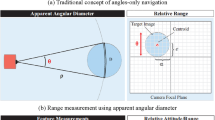Abstract
Onboard initial relative orbit determination (IROD) by using angle measurements is the key to Space Situational Awareness. The camera offset measurement method is one of the most used IROD methods when only the angle measurement is available, which can overcome the range-observability problem caused by signal-camera measurement. However, the camera offset method cannot estimate the relative-position/-velocity when the chaser-target distance is much larger than the camera offset value, which is often below five meters. To overcome this problem, an auxiliary satellite treated as the chaser’s camera with known offset is proposed in this paper, which is suitable for satellites without cameras, and the IROD algorithm is also conducted correspondingly. The Tschauner–Hempel relative orbital motion dynamics and measurement model are given first. Then the IROD algorithm is yielded as a compact form by using the state augmentation least square method. Finally, a two-body satellite’s orbit dynamics model is built to generate simulation data, and three scenarios are studied to verify the convergence of the proposed IROD algorithm. Simulation results validate the proposed IROD algorithm converges quickly, and the measurement time corresponding to the lowest relative-position estimation error is related to the distance among the target, the chaser and the auxiliary satellite.
Access this chapter
Tax calculation will be finalised at checkout
Purchases are for personal use only
Similar content being viewed by others
References
U.S. Air Force Space Command, Space Based Space Surveillance (2017)
Barnhart, D., Sullivan, B., Hunter, R., Bruhn, J., Lowler, E., Hoag, L.: Phoenix project status 2013. In: Proceedings of the AIAA SPACE Conference and Exposition (2013)
Chari, R.: Autonomous orbital rendezvous using angles-only navigation. Utah State University (2001)
Lovell, A., Lee, T.: Nonlinear observability for relative satellite orbits with angles-only measurements. In: 24th International Symposium on Space Flight Dynamics (2014)
Woffinden, D., Geller, D.: Optimal orbital rendezvous maneuvering for angles-only navigation. J. Guidance Control Dyn. 32(4), 1382–1387 (2009)
Chen, T., Xu, S.: Approach guidance with double line-of-sight measuring navigation constraint for autonomous rendezvous. J. Guidance Control Dyn. 34(3), 678–687 (2011)
Geller, D., Klein, I.: Angles-only navigation state observability during orbital proximity operations. J. Guidance Control Dyn. 37(6), 1976–1983 (2014)
Geller, D., Perez, A.: Initial relative orbit determination for close-in proximity operations. J. Guidance Control Dyn. 38, 1833–1842 (2015)
Gong, B., et al.: Analytic initial relative orbit solution for angles-only space rendezvous using hybrid dynamics method. CMES-Comput. Model. Eng. Sci. 122, 221–234 (2020)
You, Y., Wang, H.: Onboard target searching strategy during lost in space situations in angles-only navigation active space debris removal. Int. J. Aeronaut. Space Sci. 20, 1–15 (2019)
Yamanaka, K., Ankersen, F.: New state transition matrix for relative motion on an arbitrary elliptical orbit. J. Guidance Control Dyn. 25(1), 60–66 (2002)
Gong, B., Li, W., Li, S., Ma, W., Zheng, L.: Angles-only initial relative orbit determination algorithm for non-cooperative spacecraft proximity operations. Astrodynamics 2, 217–231 (2018)
Acknowledgement
This work was supported by the National Nature Science Foundation of China under Grant 61803030.
Author information
Authors and Affiliations
Corresponding author
Editor information
Editors and Affiliations
Rights and permissions
Copyright information
© 2023 The Author(s), under exclusive license to Springer Nature Singapore Pte Ltd.
About this paper
Cite this paper
Li, J., Yuan, L., Zhang, C., Zhang, S. (2023). Angles-Only Onboard Initial Relative Orbit Determination with Auxiliary Satellite. In: Sun, J., Wang, Y., Huo, M., Xu, L. (eds) Signal and Information Processing, Networking and Computers. Lecture Notes in Electrical Engineering, vol 917. Springer, Singapore. https://doi.org/10.1007/978-981-19-3387-5_74
Download citation
DOI: https://doi.org/10.1007/978-981-19-3387-5_74
Published:
Publisher Name: Springer, Singapore
Print ISBN: 978-981-19-3386-8
Online ISBN: 978-981-19-3387-5
eBook Packages: EngineeringEngineering (R0)




